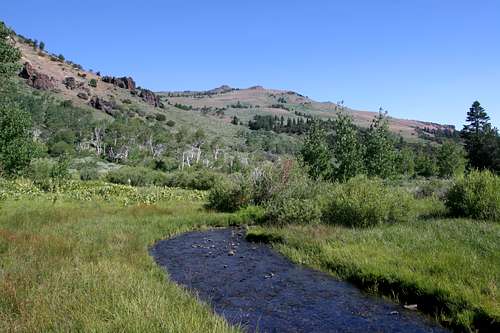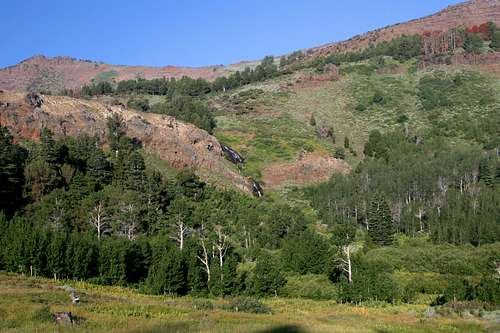-
 17327 Hits
17327 Hits
-
 89.01% Score
89.01% Score
-
 28 Votes
28 Votes
|
|
Mountain/Rock |
|---|---|
|
|
41.41882°N / 120.21875°W |
|
|
Modoc |
|
|
8646 ft / 2635 m |
|
|
Overview
The Warner Mountains extend from southern Oregon south into the far northeastern corner of California in a long, narrow line of peaks that rise high above the arid plains. The northern 2/3’s of the range have peaks that often exceed 8,000 feet. The final, southernmost 1/3 of the Warner Mountains differs dramatically from the rest of the range. Here, the peaks are arranged along a high crest running north to south. Far more rugged, the high peaks found here soar to just short of 10,000 feet. The two lords of the crest are Eagle Peak, the Warner Mountains highpoint and Warren Peak, only slightly shorter but far more rugged. Although not nearly as tall as the twin giants to the south, Squaw Peak is the final, solitary parapet of the Warner Mountains southern cluster of high peaks. In spite of its diminutive height compared to its neighbor’s, Squaw Peak remains the highest peak in the Warners north of Warren Peak.
Squaw Peak is roughly pyramidal in structure, capped by a small stone turret. The western face of the peak is simply an extension of the long, gradually slope that rises out of the flatlands of the Modoc Plateau. Only 350 feet higher than the crest, the mountain does not offer a particularly imposing profile. Looks are deceiving however, since the Warner Mountains possess a rugged eastern escarpment that drops away swiftly on the eastern side. From the summit, the eastern slope of the mountain loses elevation at much the same angle as the western side. It is the northern and southern sides of Squaw Peak that are steepest and most rugged. Topping all of this is a small stone turret
What Squaw Peak lacks in height and ruggedness (at least in relation to Eagle and Warren Peaks), it compensates with exquisite atmosphere and vistas. Squaw Peak is, in some ways, the most characteristic peak of the Warner Mountains. Here one finds unusual rock formations caused by wind erosion, massive rock formations composed of the volcanic rock that makes up the rest of the ranger, vast seas of bunchgrass and sage, clear flowing creeks surrounded by lush meadows and glorious aspen groves. Swuaw Peak is the divide between three creek watersheds, on the western slope, the South and Middle Fork of Parker Creek flow into the Modoc Plateau and feed the Pit River. Milk Creek begins in the vast meadow below the northern ramparts of the peak. To the south, Cottonwood Creek flows through the beautiful Cottonwood Basin, one of the most beautiful drainages in the Warner Mountains.
Vistas from the summit of Squaw Peak are excellent. The entirety of Cottonwood Basin is marvelously close. The hulking mass of Warren Peak dominates the horizon, although distant Dusenbarry Peak, one of the Warner Mountain’s higher peaks is visible peering around Warren’s shoulder. To the west the vast expanse of the Modoc Plateau is visible. Lassen Peak and Mount Shasta punctuate the distant horizon. To the east, the Surprise Valley and the three sometimes full/sometimes dry Alkali Lakes are seen 4,000 feet below the summit. The eastern side of the Surprise Valley is in Nevada and distant Great Basin Peaks can be seen. To the north, the rest of the Warner Mountains can be observed as they stretch into Oregon.
South Warner Wilderness
One of the 1964 Wilderness Act’s freshman class, the South Warner Wilderness remains one of California’s most remote and least visited wilderness areas. The wilderness is found at the southern end of the Warner Mountains and is the only wilderness area in the range. Containing 70,614 in an area 18 miles long and 8 miles wide. 10 lakes are found in the wilderness, though Patterson Lake is the largest, prettiest and attracts the most attention, scant as it is.
Nearly 100 miles of trail penetrate the wilderness. The highlight of these is Warner Crest Trail, which traverses the highest portions of the wilderness. Combining this trail with the Squaw Peak and Owl Creek Trails creates a spectacular 45 mile loop that travels above top of the range and then passes below the crest rim through the rugged, eastern drainage basins. Most of the lakes are passed and the highest peaks are close to the Crest Trail. Few venture into the wilderness. Most who do are locals or shepherds, the preponderance of whom seem to be from Peru.
Getting There
From the junction of Highway 299 and Highway 395 in Alturas, head south on Highway 395. At the south end of downtown, turn left (east) on County Road 56, which is also named E. McDowell. The road winds for several miles, climbing up to a levee and passing a reservation casino before dropping into a shallow canyon. Views of the west slope of the Warners are excellent. Eagle, Warren and Squaw Peaks are prominently visible. Eventually the road enters Modoc National Forest and becomes Forest Road 31. Although the pavement ends the road is in excellent condition and is passable by sedans. After climbing a few more miles through the forest turn right onto Forest Road 42N79. Look for signs marking Pepperdine Camp. Do not turn left to go to the horse camp but continue straight a short distance to the parking lot at the marked trailhead.
When To Go
Summer has spectacular wildflower displays throughout the Warners. October is also an excellent time to go, since the abundance of aspens means awesome fall colors. Many creeks flow year-round, but the presence of lakes assures the availability of water. The Warner Mountains is often buried in snow until mid-June. The hiking season generally lasts from then until October. The road to Pepperdine Camp is not plowed and impassable in winter. Access is difficult before the temperatures increase.Red Tape
Squaw Peak is located in the South Warner Wilderness. Normal wilderness rules and ethics apply.
Modoc National Forest provides an excellent map for the South Warner Wilderness
Grazing is permitted in the Warner Mountains, so it is possible to see sheep or cattle. Because of this, it is a good idea to filter water.
Modoc National Forest
800 West 12th Street
Alturas, CA 96101
(530) 233-5811
Warner Mountain Ranger District
PO Box 220
Cedarville, CA 96104
(530) 279-6116
Camping
The nearest campground is available at Pepperdine Camp, near the trailhead. Dispersed camping is allowed throughout the forest, so camping is permitted at the trailhead. There is no water near the summit of Squaw Peak. The best campsites around the peak are along the Squaw Peak Trail at the Milk Creek headwaters or along Cottonwood Creek in Cottonwood Basin. The nearest campsite to the summit with water is at Cottonwood Lake.
External Links
- Modoc National Forest







